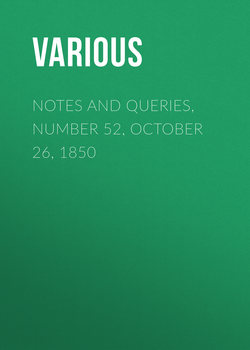Читать книгу Notes and Queries, Number 52, October 26, 1850 - Various - Страница 3
NOTES
ORATORIES OF THE NONJURORS
ОглавлениеAs the nooks and corners of London in olden times are now engaging the quiet musings of most of the topographical brotherhood, perhaps you can spare a nook or a corner of your valuable periodical for a few notes on the Oratories of those good men and true—the Nonjurors. "These were honourable men in their generation," and were made of most unbending materials.
On the Feast of St. Matthias, Feb. 24, 1693, the consecrations of Dr. George Hickes and Thomas Wagstaffe were solemnly performed according to the rites of the Church of England, by Dr. William Lloyd, bishop of Norwich; Dr. Francis Turner, bishop of Ely; and Dr. Thomas White, bishop of Peterborough, at the Bishop of Peterborough's lodgings, at the Rev. William Giffard's house at Southgate in Middlesex: Dr. Ken, bishop of Bath and Wells, giving his consent.
Henry Hall was consecrated bishop in the oratory of the Rev. Father in Christ, John B– [Blackburne?], in Gray's Inn, on the festival of St. Barnabas, June 11, 1725.
Hilkiah Bedford was consecrated in the oratory of the Rev. R– R– [Richard Rawlinson], in Gray's Inn, on the festival of St. Paul, Jan. 25, 1720. Ralph Taylor was also consecrated at the same time and place.
Henry Gandy was consecrated at his oratory in the parish of St. Andrew's, Holborn, on the festival of St. Paul, Jan. 25, 1716.
Grascome was interrupted by a messenger whilst he was ministering to his little congregation in Scroope's Court, near St. Andrew's Church.
Jeremy Collier officiated at Broad Street, London, assisted by the Rev. Samuel Carte, the father of the historian.
Mr. Hawkes officiated for some time at his own house opposite to St. James' Palace.
On Easter-day, April 13, 1718, at the oratory of his brother, Mr. William Lee, dyer, in Spitalfields, Dr. Francis Lee read a touching and beautiful declaration of his faith, betwixt the reading of the sentences at the offertory and the prayer for the state of Christ's church. It was addressed to the Rev. James Daillon, Count de Lude, then officiating.
Charles Wheatly, author of A Rational Illustration of the Book of Common Prayer, in a letter to Dr. Rawlinson, the nonjuring titular bishop of London, says:
"I believe most of the books in Mr. Laurence's catalogue were really in his library. Most of his chapel furniture I had seen; but his pix, and his cruet, his box for unguent, and oil, I suppose you do not inquire after."
Roger Laurence was the learned author of Lay Baptism Invalid. Query, Where did he officiate?
The Rev. John Lindsay, the translator of Mason's Vindication of the Church of England, for many years officiated as minister of a nonjuring congregation in Trinity Chapel, Aldersgate Street, and is said to have been their last minister.
Thoresby, in his Diary, May 18, 1714, says, "I visited Mr. Nelson (author of the Fasts and Festivals), and the learned Dr. George Hickes, who not being at liberty for half an hour, I had the benefit of the prayers in the adjoining church, and when the Nonjuring Conventicle was over, I visited the said Dean Hickes, who is said to be bishop of –" [Thetford]. Both Nelson and Hickes resided at this time in Ormond Street; probably the conventicle was at one of their houses. It should be noted that Thoresby, having quitted the Conventicles of the Dissenters, had only recently joined what he calls the Church established by law. He appears to have known as much about the principles of the Nonjurors as he did of Chinese music.
Dr. Welton's chapel in Goodman's Fields being visited (1717) by Colonel Ellis and other justices of the peace, with proper assistants, about two hundred and fifty persons were found there assembled, of whom but forty would take the oaths. The doctor refusing them also, was ordered to be proceeded against according to law.
This reminds me of another Query. What has become of Dr. Welton's famous Whitechapel altar-piece, which Bishop Compton drove out of his church. Some doubts have been expressed whether that is the identical one in the Saint's Chapel of St. Alban's Abbey. A friend has assured the writer that he had seen it about twenty years ago, at a Roman Catholic meeting-house in an obscure court at Greenwich. It is not there now. The print of it in the library of the Society of Antiquaries is accompanied with these MS. lines by Mr. Mattaire:—
"To say the picture does to him belong,
Kennett does Judas and the painter wrong;
False is the image, the resemblance faint,
Judas, compared to Kennett, was a saint."
One word more. The episcopal seal of the nonjuring bishops was a shepherd with a sheep upon his shoulders. The crozier which had been used by them, was, in 1839, in the possession of John Crossley Esq., of Scaitcliffe, near Todmorden.
J. Yeowell.
Hoxton.
